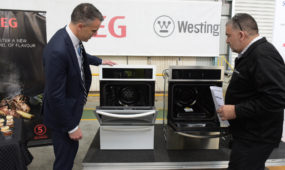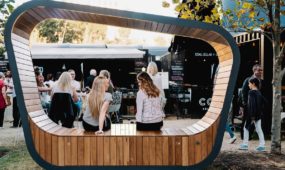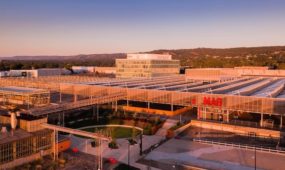Bowhill Engineering against the odds
Manufacturing
BOWHILL Engineering specialises in success against the odds. Their niche is in fabricating large steel components for small projects and developing methodologies for things that have never been done.

Sign up to receive notifications about new stories in this category.
Thank you for subscribing to story notifications.
They've worked on parts of South Australia's most recognisable infrastructure projects, from fabricating the complex, rotated frame of the Wayville Pedestrian Overpass to transporting major sign gantries and bridge beams for the Southern Expressway.
They also have a hand in national projects such as the Square Kilometre Array in Western Australia, and upgrading just about every loch and weir of the lower River Murray. Their clients include McConnell Dowell, Lend Lease and Raytheon.
The business is a long way from where it started and, quite literally, a fair way from most things. Brendon and Averil Hawkes moved from the beachside suburb of Glenelg to Bowhill on the banks of the Murray River in the early 1970s. It lies around 150 kilometres out of Adelaide.
Their son, now Managing Director, Jeremy Hawkes explains that the family plan of becoming broad acre farmers took something of a turn.
“My grandfather had a mechanical repair workshop in Glenelg. When my father moved up to the country to be a farmer he still had that in his blood and developed a facility to repair his own equipment,” Hawkes said.
That marked the beginnings of Bowhill Motors, as it was known then. Other locals and farmers in the area saw Brendon Hawkes' capabilities and came knocking on the door to have him work on their equipment too.
“My father prided himself on being able to fix almost anything in-house. That was his goal, his ambition. He was able to be very resourceful with what he had.”
It's an attitude and ability that carries through to Bowhill Engineering today.
Jeremy took up his apprenticeship as a heavy vehicle mechanic. Eventually his older brother Simon returned to join the family business, which marked a restructuring towards steel fabrication.
“It came to a point when we were half doing farming and half doing engineering and we didn't feel like we were doing either really well. We had an ambition to do whatever we were doing as well as we possibly could.”
They leased the farm and built a new facility in Bowhill, starting the hunt for structural steel fabrication work.
Tragically, in October 2002, the family received a call that Simon had been killed in a car accident.
Bowhill Engineering recently accepted Telstra's 2014 SA Regional Business Award. During a powerful speech to a rapt audience, Jeremy Hawkes explained the role his brother played.
“My brother Simon had a very strong entrepreneurial spirit. He was technically brilliant as well. It's accurate to say that Bowhill wouldn't exist, certainly not in its current form, without Simon's vision and unwavering courage,” he said.
“Back then we were employing about thirteen people, and rocking up and facing those guys was one of life's most difficult moments. At that point the Hawkes family was galvanised forever.
“Myself, a 28 year old, relatively uneducated larrikin, spoke on the family's behalf. I stood in front of everybody and delivered a message to everybody that I had no right to. I said to our staff, 'we can do this. If you guys stick with us, step up and have a crack, I guarantee you the Hawkes family will not let you down.'”
That was twelve years ago. The Hawkes and Bowhill have had many ups and downs since then too – but that's part of the tapestry of life, Jeremy believes.
The Hawkes family has come good on their promise. They've expanded and the scope of their work includes projects that they would have never dreamed about a decade ago.
One of the most striking is the twisting pedestrian overpass that was recently installed at Adelaide's new Wayville train station.
The overpass is a complex 50 metre long structure with a frame that twists 90 degrees over its length, built in collaboration with major engineering and construction firm McConnell Dowell.
“The way to succeed in those jobs is to approach it collaboratively with the client. If we can all work together we can all make each other's lives so much easier,” Hawkes said.
Each section of the frame rotates by nine degrees. The process was, by necessity, low tolerance and high precision.
“We had to be very, very involved right at the start of that job in methodology development. Everybody sat across the table and looked at me, asking 'how are we going to build this thing and get it to the site?'
“I really relish that opportunity to be involved in design, and for engineers and architects and builders to look across the table at me, I felt quite special about that.”
Bowhill had to figure out a way to build the structure and error-proof it along the way. The solution was a massive, 60 metre long jig to trial the components before they went to site.
“The jig didn't just stop there. We took it to the site and used it for sub-assembly, for each half of the bridge on each side of the track. So that jig went from being an error-proof tool at our facility to being an erection tool on the site.”
As further proof of Bowhill's outside of the square methodologies, the beam they used for the jig was a second hand component from their client's previous job, making the whole process more affordable.
“We try and come up with a win-win situation. You're not just trying to build a jig for one thing, you're building a jig that's suitable for multiple purposes.”
Because of the larger size of the components that Bowhill Engineering typically deals with, their clients will often task them with transport to the site in order to minimise their own risk.
It's a responsibility that Hawkes cherishes – because loading it in their own yard means they have total control over the process, reducing the risk of damage to the components or their coatings.
Transporting massive beams for a bridge development on the Southern Expressway development on a very squeezed budget is one example of their expertise in that area.
“We had to think outside the box, take a calculated risk, and we transported all eight beams of that bridge down on one truck. No one had seen that done before.”
Traditionally, the job would take four trucks with cranes waiting for them to arrive on time. Expensive work.
Bowhill designed and fabricated a cradle with all eight beams loaded on it. The truck would raise its hydraulics, lifting the cradle and load with it, drive the load to the site and lower their hydraulics.
“The client could pick any beam they wanted from the cradle at any time they wanted. No pressures to have the cranes meet the trucks and unload quickly, no double handling. It was a pretty cool load too. 33 metres long and it weighed about 80 tonnes.”
The secret to the company's flexibility in being able to complete such diverse projects is not to lock themselves in to any specific technology. Their own fabrication workshop has focused strongly on surface treatment, but they rely on their suppliers for other equipment.
“We tap in to all the technology we possibly can, and there's plenty of it in South Australia. We don't own it ourselves though, and that's a deliberate strategy because it gets out of date so quickly,” Hawkes said.
“We want to be like a chameleon. We want to be so flexible, so attuned to the next job that we don't want to be locked in to owning equipment that won't suit that next job.”
Their relationships with suppliers depend on paying on time, on being reasonable and being loyal. Hawkes' attitude to staff runs on the same lines.
“We're really focused on having a sustainable workforce. We don't work 70 hours a week. We make sure we can do what we do with a sustainable work-life balance, and I think that's a unique thing.”
Overtime is reserved for emergencies rather than having it as a given. If a staff member's out of work relationships with their family or partner are being stretched, it's not healthy for them or their performance.
“It's about caring for people, listening to people and being genuine. They're not just a number, they're not just a tool. They're a person and they matter a lot. They're valuable to the company and what they do makes a difference.”
In recognition of his leadership, Jeremy Hawkes has been awarded as a recipient of the Industry Leaders Fund for the last two years running, the only person to have done so.
The grant sent him on Shinka Management's Lean Japan Tour, visiting companies like Toyota, Rinnai and Panasonic and learning about their lean processes – both on the factory floor and in management.
“The take away for me was getting employees engaged. You have to look at it from the employee's perspective – you have to build the story and build the incentives around focusing on and looking after their company.
“That's a cultural thing in Japan. If we can do that, they'll start to think of beneficial, continuous improvement for the company's sake, not just their own. That's the big difference I saw – it was the improvement coming from everybody, not just management pushing it on people,” Hawkes explained.
Bowhill's location on the banks of the Murray provides a good lifestyle for the company, but it brings along challenges as well. The beauty for Hawkes and his team is that collaboration comes easily over the Internet.
“Tools you can use, electronic tools, are making our location a lot more competitive. You don't need expensive software. It's great to involve your client with a model while you're developing it.”
Clients can see what Bowhill are designing and proposing, and likewise Bowhill can send queries their way when a technical issue arises – and both parties will be looking at exactly the same model.
It's that dedication to delivering excellent service and QA, despite a reasonably remote location, that named Bowhill Engineering the Telstra South Australian Regional Business of the year 2014.
“We very much take is as win for our region, as a beacon of light that you can do amazing things even if you're based in the country.
“If you put the expectations there that you want to be world class and you want to be something special, it doesn't matter where you are. If you're genuine and you firmly believe that you can achieve it, amazing things can happen. That's our attitude.”
Jump to next article



